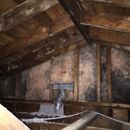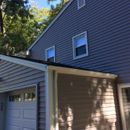Insulating wall next to garage ceiling
I live in NJ and had an energy audit done last year but I found that two of my rooms still remained cold.
These are two bedrooms where half of the rooms are above a garage. The exterior walls of these two rooms have part of the walls with no sheathing (see photo one). This area is cold because the garage roof has soffit and ridge vents so there is cold air in the winter. dense pack cellulose was blown into the garage ceiling joists below these two rooms, but it is still cold near these exterior walls.
The house is a 1960 split level that has a finished attic on the third floor and as part of the energy audit they put 2 inch polyiso rigid foam board over the existing insulation for the knee wall area in the attic along with blowing in dense pack cellulose in the floor joists in
I was hoping that if I replaced the old fiberglass and then covered it with the 2 inch polyiso board and used spray foam to seal the gaps (similar to what they did in my attic knee wall in photo 3) that it would help make those rooms warmer, but I wasn’t sure if it would cause potential moisture issues. Is this OK or is there another better solution?
I have attached three photos:
1. shows the area of the wall in question when looking through the garage ceiling
2. shows the outside of the house for the area in question
3. shows attic knee wall area insulated with Dow Super Tuff-R 2 inch polyiso rigid foam board from the energy audit
thanks for your help
GBA Detail Library
A collection of one thousand construction details organized by climate and house part












Replies
Max,
Q. "I was hoping that if I replaced the old fiberglass and then covered it with the 2 inch polyiso board and used spray foam to seal the gaps (similar to what they did in my attic knee wall in photo 3) that it would help make those rooms warmer, but I wasn't sure if it would cause potential moisture issues. Is this OK?"
A. Yes, the plan you describe is a good one. This wall shows signs of air leakage. (The reason that fiberglass batts get black stains is that they are filtering out the dust particles from the exfiltrating air that is leaking out of your house into the garage attic.)
While you are at it, you should pay attention to the uninsulated duct in the photo. I don't know if it's a supply air duct or a return air duct, but in either case it needs to be carefully insulated. As you probably know, the duct seams should be sealed with mastic before the duct is insulated.
.
That duct is a supply. So I should just insulate the portion of the duct shown in the picture? The rest of the ductwork runs through the floor joists above the garage and are filled with dense packed cellulose (you can see the overflow near the duct)
I can replace the old duct tape currently on the joints with polyken mastic tape
Max,
Q. "So I should just insulate the portion of the duct shown in the picture?"
A. Yes. A galvanized heating or cooling duct installed in an unconditioned space always needs duct insulation.